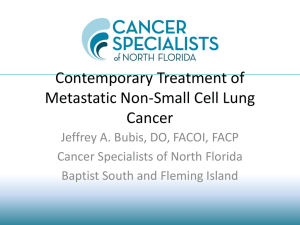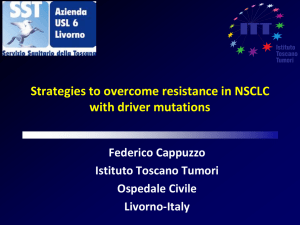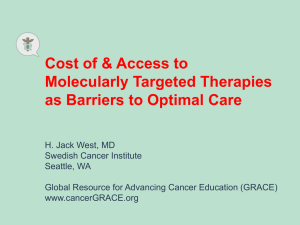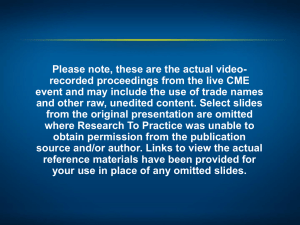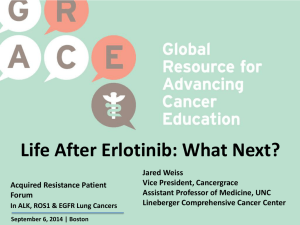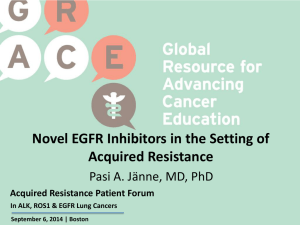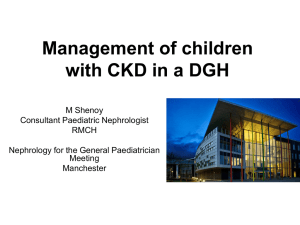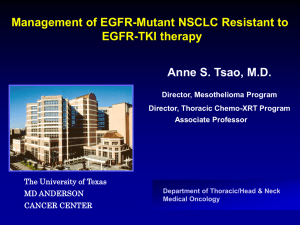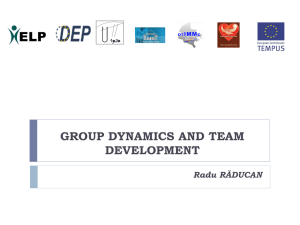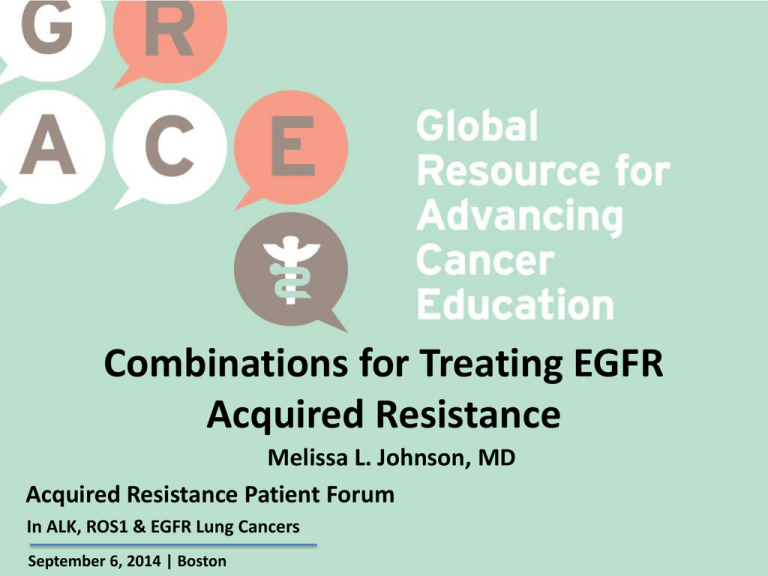
Combinations for Treating EGFR
Acquired Resistance
Melissa L. Johnson, MD
Acquired Resistance Patient Forum
In ALK, ROS1 & EGFR Lung Cancers
September 6, 2014 | Boston
Combination Treatments for EGFR Acquired Resistance
Dx: EGFR+ lung
cancer
Tarceva
Gilotrif
Acquired
Resistance
Tarceva
+
NEW DRUG
Gilotrif
+
NEW DRUG
Combination Treatments for EGFR Acquired Resistance
Can we make 1st Gen TKI Better?
• We have tried!!
• Selected approaches to enhancing EGFR TKI in order to overcome or
prevent resistance
Erlotinib + Chloroquine
Erlotinib + Sirolimus
Erlotinib + Onartuzumab (anti-Met)
Erlotiinb + Entinostat
Erlotinib + R1507 (anti IGF-1)
Erlotinib + Tivantinib
Erlotinib + Sorafanib
Erlotinib + Dasatinib
Erlotinib + MK2206 (AKT)
Erlotinib + MM-121 (anti-ErbB3)
Erlotinib + XL184
Erlotinib + Rilotumumab (anti-HGF)
Erlotinib + Patritumumab (anti-ErbB3)
Erlotinib + AUY-922 (HSP 90 inhibitor)
Slide adapted, courtesy of Thomas J. Lynch, Jr., MD
Combination Treatments for EGFR Acquired Resistance
Dx: EGFR+ lung
cancer
Tarceva/Gilotrif
(erlotinib/afatinib)
+
NEW DRUG
Acquired
Resistance
Combination Treatments for EGFR Acquired Resistance
Flare associated with shorter TTP
14 of 61 patients (23%, 95% CI 14-35%) had a disease flare
(hospitalization or death)
• Median time from last TKI to flare was 8 days (range 3-21 days)
• 3 patients went on to trial treatment
•
Chaft, Clin Cancer Res 2011
Combination Treatments for EGFR Acquired Resistance
AUY922:
An “Onco-Chaperone” Inhibitor
AUY922 (in yellow) is a synthetic isoxazole resorcinol HSP90
inhibitor, shown here bound to the deep ATP pocket of
HSP90 (in blue)
Neckers and Workman Clin Cancer Res 2012
AUY922+ Erlotinib
Melissa L. Johnson
Combination Treatments for EGFR Acquired Resistance
AUY922 + Erlotinib
Phase I Dose-Escalation
Cohort
Dose of AUY922 IV
weekly
Dose of Erlotinib PO
daily
# pts enrolled
1
2
3
4
5
25 mg/m2
25 mg/m2
37.5 mg/m2
55 mg/m2
70 mg/m2
75 mg
150 mg
150 mg
150 mg
150 mg
3
3
3
3
6
AUY922+ Erlotinib
Melissa L. Johnson
HSP90 Inhibitors in Lung Adenocarcinoma
Preliminary Activity
Patient 01-102
AUY922 25 mg/m + Erlotinib 75 mg
Duration of therapy: 6 months
C1D1
AUY922+ Erlotinib
C1D28
Melissa L. Johnson
AUY922 + Erlotinib
Phase II Study Design
Stage IV
Adenocarcinoma
+EGFR mutation
Acquired Resistance
Biopsy at resistance
30 day erlotinib lead-in
Erlotinib 150mg PO qday
AUY922 70mg/m2
Key Inclusion Criteria
•Advanced lung adenocarcinoma
•EGFR mutation OR previous response to EGFR TKI
•EGFR TKI for ≥6 months and 1 full month prior to
study start
•Biopsy at time of acquired resistance to EGFR TKI
Key Exclusion Criteria
•Brain metastasis that are symptomatic and/or
requiring escalating doses of steroids
•Systemic treatment within 4 weeks, RT within 2
weeks
Primary endpoint: Overall response rate ORR (CR + PR)
Secondary endpoints: Progression-free survival, Overall survival, ORR in T790M+, Toxicity
Definition of Acquired Resistance19
• Previously treated with single-agent EGFR-TKI
• Tumor harbors TKI-sensitive EGFR mutation (G719X, ex 19 del, L858R,
L861Q)
• EITHER RECIST-defined PR/CR OR ≥ 6 months clinical benefit (SD) with
single-agent EGFR-TKI followed by systemic POD
19
Jackman JCO 2009
Statistical Considerations:
• stage I: 16 pts (if ≥2 responses, proceed to stage II)
• stage II: 9 pts (if ≥ 5 responses overall, AUY922 and erlotinib
are worthy of further study)
• α=10%; β=10%; p0=10%; p1=30%
Melissa L. Johnson
Molecular Characteristics
N=37
AUY922
25-55
2
mg/m
N=12
AUY922
70
2
mg/m
N=25
EGFR exon 19 deletion
25
10
15
EGFR exon 21 L858R
11
2
9
EGFR exon 21 L861Q:
1
0
1
EGFR T790M found on repeat Tumor Biopsy, n (%)
16 (43%)
6 (50%)
10 (40%)
Median duration of EGFR-TKI therapy prior to
developing acquired resistance, months (range)
12 (2-42) 13 (8-32) 11(2-42)
Primary EGFR mutations
EGFR mutation unknown
AUY922+ Erlotinib
Melissa L. Johnson
Best Response to AUY922 and Erlotinib
100%
N=24
Best % change in target lesions
80%
60%
40%
20%
0%
-20%
-40%
Progressive disease
Stable disease
Partial response
EGFR T790M
-60%
Partial Response (PR): 4/25 (16%)(95% CI 6-35%)
Disease Control Rate (DCR): 14/25 (56%)(95% CI 37-73%)
AUY922+ Erlotinib
Melissa L. Johnson
Individual Responses According to EGFR Mutations and Time on Primary EGFR-TKI
Pt ID
96-501
96-502
96-503
96-504
01-505
96-506
96-02
96-03
96-04
96-05
96-06
96-07
96-08
96-09
96-10
96-11
96-12_
96-13
96-14
96-15
96-16
96-17
96-18
96-19
01-20_
EGFR
19/21
21
21
19
21
L861Q
21
19
19
19
19
21
21
21
19
21
19
21
19
19
19
19
21
19
19
19
*
T790M
Best
Response
AUY922 +
Erlotinib
Cycles
Completed
Duration
primary
EGFR-TKI
(prior to AR)
T790M
T790M*
T790M
—
—
T790M
—
—
T790M
—
—
—
T790M
Unk
—
T790M
—
T790M
—
—
—
T790M
—
—
T790M
SD
SD
PR
POD
POD
POD
POD
POD
POD
SD
SD
POD
POD
POD
POD
PR
PR
PR
SD
NEΩ
SD
SD
POD
NE∆
NE∆
2
1
2
1
1
1
1
1
1
3
3
1
1
1
1
3
13
3
1
1
2
6
1
1
2
7.43
11.00
11.57
9.57
10.00
20.80
25.63
4.40
10.10
2.30
17.87
11.93
12.80
8.83
15.47
42.00
19.80
25.00
14.77
7.50
6.60
10.73
3.03
16.63
6.00
Small cell transformation
Reason withdrawn from study
DLT-prolonged QTc; junctional rhythm
Ophthalmologic tox ( gr 2 night blindness)
Ophthalmologic tox (gr 2 night blindness/blurred)
POD
POD
POD
POD
POD
POD
POD
Patient withdrew consent
POD
POD
Patient withdrew consent
POD
Patient withdrew consent
Hepatic tox (gr 3 LFT elevation)
Opthalmologic tox (gr 2 night blindness)
Hepatic tox (gr 3 LFT elevation)
Diarrhea (gr 3 colitis)
POD
POD
POD
POD
patient remains on study
Combination Treatments for EGFR Acquired Resistance
Afatinib + Cetuximab
Combination Treatments for EGFR Acquired Resistance
Dual Inhibition of EGFR with Afatinib and Cetuximab
in Kinase Inhibitor-Resistant EGFR Mutant Lung
Cancer with and without T790M
Dose escalation schema 3–6
patients per cohort
Pathology confirmed
NSCLC with
EGFR
mutation1
OR
SD 6 months
on erlotinib/gefitinib
OR
Partial or complete
response
to erlotinib/gefitinib
ECOG PS 0-2
Age ≥ 18 years
Disease
progression2
Stop erlotinib/
gefitinib for
≥72 hours3
Afatinib p.o. daily + escalating
doses of i.v. cetuximab q 2
weeks
Dose levels starting at:
afatinib 40 mg +
cetuximab 250 mg/m2
Predefined maximum dose:
afatinib 40 mg +
cetuximab 500 mg/m2
MTD cohort expanded up to 80 EGFR
mutation-positive patients4:
40 T790M+ and 40 T790M–
Janjigian, et al. Cancer Discovery 4(9): 1-10, 2014
Combination Treatments for EGFR Acquired Resistance
Tumor Regression by T790M Mutation Status
at Recommended Dose
Horn at al. IASLC 2011
16
Janjigian, et al. Cancer Discovery 4(9): 1-10, 2014
Combination Treatments for EGFR Acquired Resistance
Cetux/Afatanib Toxicity
N=126
All grades
Gr 3-4
Rash
114 (90%)
25 (20%)
Diarrhea
89 (71%)
8 (6%)
Nail Effect
72 (57%)
0 (0%)
Stomatitis
71 (56%)
1 (1%)
Fatigue
59 (47%)
3 (2%)
Nausea
53 (42%)
3 (2%)
Xerosis
53 (42%)
3 (2%)
Janjigian, et al. Cancer Discovery 4(9): 1-10, 2014
Combination Treatments for EGFR Acquired Resistance
Preliminary Efficacy Comparison
RR
T790M +
RR
T790M -
PFS
(months)
Tarceva/AUY922
30%
10%
1.7
Afatanib/Cetux
32%
28%
4.66
CO-1686
58%
Inc.
AZD 9291
65%
22%
18
Toxicity Comparison
Diarrhea
Rash
Unique Toxicities
Tarceva/AUY922
95%
81%
Afatanib/Cetux
71%
97%
Night blindness, elevated LFTs,
prolongation of QTc
Nail effects, stomatitis
Tarceva/Bevacizu
mab
81%
99%
Any Grade
19
Hypertension, Proteinuria
Combination Treatments for EGFR Acquired Resistance
T+A vs T (#8005)
• BeTa in second line setting
• ATLAS as maintenance
Unselected
Patient
Population
– Both with compelling results in enriched
populations of never smokers, East Asians
• Possible EGFR regulation of VEGF in EGFR
mutant cell lines (Heymach)
Combination Treatments for EGFR Acquired Resistance
JO25567 Study Design
Chemotherapy-naïve
Stage IIIB/IV NSCLC or
postoperative recurrence
Non-squamous
Activating EGFR mutations*
Exon 19 deletion
Exon 21 L858R
1:1
PS 0–1
Stratification factors: sex,
smoking status, clinical stage,
EGFR mutation type
*T790M excluded
Abstract 8005: Presented by Terufumi Kato
PD
E monotherapy
Erlotinib 150mg qd
(n = 75)
PD
R
Age ≥20 years
No brain metastasis
EB combination
Erlotinib 150mg qd +
bevacizumab 15mg/kg q3w
(n = 75)
•
•
•
Primary endpoint: PFS (RECIST v1.1,
independent review)
Secondary endpoints: OS, tumor response,
QoL, safety
Exploratory endpoint: biomarker assessment
Combination Treatments for EGFR Acquired Resistance
Primary endpoint: PFS by independent review
EB
E
Median (months)
1.0
HR
P value*
0.8
PFS probability
0.54 (95% CI: 0.36–0.79)
*log-rank test, two-sided
0.6
EB
E
0.4
0.2
9.7
0
16.0
0
2
4
6
8
10
12
Number at risk
EB
75
E
77
72
66
69
57
64
44
60
39
53
29
49
24
14 16 18
Time (months)
38
21
Abstract 8005: Presented by Terufumi Kato
30
18
20
12
20
22
24
26
28
13
10
8
5
4
2
4
1
0
0
Combination Treatments for EGFR Acquired Resistance
PFS by EGFR Mutation Type
Exon 19 deletion
Exon 21 L858R
EB group
E group
18.0
10.3
0.41
(95% CI: 0.24–0.72)
Median (months)
HR
1.0
Median (months)
HR
1.0
0.8
PFS probability
PFS probability
0.8
EB group
E group
13.9
7.1
0.67
(95% CI: 0.38–1.18)
0.6
0.4
EB
0.2
0.6
0.4
EB
0.2
E
E
0
0
0 2 4 6 8 10 12 14 16 18 20 22 24 26 28
0 2 4 6 8 10 12 14 16 18 20 22 24 26 28
Time (months)
Time (months)
Number at risk
Number at risk
EB
40 39 38 36 33 29 27 24 19 12 8
5
2
2
0
EB 35 33 31 28 27 24 22 14 11 8
5
3
2
2
0
E
40 35 29 26 22 16 12 9
1
0
0
0
E
7
4
2
1
0
9
5
3
Abstract 8005: Presented by Terufumi Kato
37 31 28 18 17 13 12 12 9
7
Combination Treatments for EGFR Acquired Resistance
Toxicity with Tarceva + Avastin
JO25587
• No unforeseen toxicities or Rx-related deaths
• Grade >3 toxicity 91% vs. 53% (esp. HTN, proteinuria)
• 41% discontinued bevacizumab for adverse effects
– Primarily proteinuria (15%) or hemorrhagic (12%)
– Bevacizumab discontinuation rate 10-15% in BeTa,
ATLAS trials
Combination Treatments for EGFR Acquired Resistance
18
EGFR + NSCLC TrialsPFS (months)
16
16
13.1
14
13.6
11.0
12
10
Med
PFS (mo)
9.7
9.7
8
6
4
2
0
EURTAC 1
EURTAC
OPTIMAL 2
OPTIMAL
Lux-LUNG-3
LUXLung-33
Lux-Lung-6
LUXLung-64
JO-25567-E
JO25587Tarceva5
JO-25567-E/B
JO25587T/A5
1. Rosell et al. Lancet Oncol. 2012;13:239; 11. Zhou et al. Lancet Oncol. 2011;12:735; 3. Sequist et al. J Clin Oncol.
2013;31:3327; 4. Wu et al. Lancet Oncol. 2014;15:213; 5. Kato, Proc ASCO 2014, A#8005
Combination Treatments for EGFR Acquired Resistance
What’s next?
Akbay et al. Cancer Discovery 3:1355-1363, 2013
Combination Treatments for EGFR Acquired Resistance
Summary
• TWICE the opportunity for success, but
TWICE the side effects
• Upfront or after the development of
Acquired Resistance?
• Future Directions: Tarceva + PDL-1 inhibitor?

